Whitney Johnson

Your work uses a lot of geometric ratios and patterns, as well as repeating shapes or images. What drew you to this particular style?
I was first introduced to how the laws of geometry are used in art and architecture a few years ago, and it was very exciting for me at the time. I learned how to use eternal laws to compose a space, and I saw how they could help me in finding truth and beauty in my artwork. Right away the importance of using geometry in my art seemed so obvious to me. I honestly felt like I had finally found something I didn’t even realize I was missing. I was also drawn towards using patterns and repeating shapes because their continuity is symbolic of the Infinite, and I felt that by using them along with implementing the laws of geometry, my artwork had a divine purpose and significance.
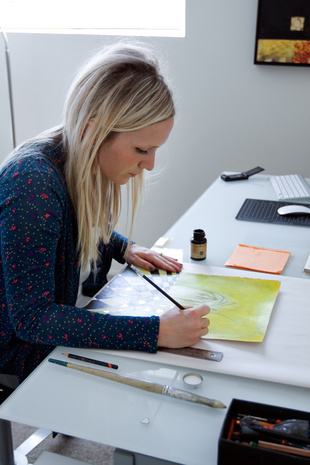
Is there a particular piece that you consider your personal best? Why?
I am my own biggest critic and there are always things I would change about my paintings when I look back on them, so I’m not sure I could call one specific painting my “personal best.” If I had to choose one that felt the most fulfilling I think it would be “Words of Isaiah.” I worked on this painting off and on for five months and it ended up completely different from how it started, but I think it was a successful painting in more ways than one, including the color contrast and the use of one-point perspective.
What do you want your paintings to convey?
The concepts behind each of my paintings are very personal to me, but I still think anyone who is ready and willing can benefit from them. I use a lot of symbolism in my work that I use for specific reasons, but my hope is that the viewers can interpret the symbols in their own personal way so that they have a unique, individual experience with the painting. Through their experience, they are led to view a concept differently and feel enlightened as they see things in their life more clearly, or understand a concept more fully.
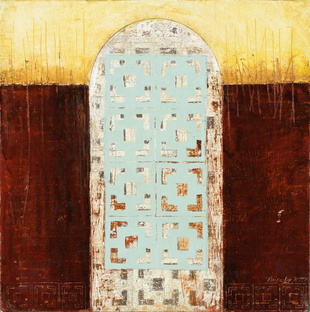
In your blog post on Friday, October 3rd, 2009, you shared an email from your mother regarding your artistic talent as a child. In that post youu mentioned that the professor told you—rather emphatically—that there is no such thing as a part-time artist. When did you begin to define yourself as an artist?
My freshman year of high school I received some positive feedback from my art teacher and immediately felt that this was something I should pursue. My parents were very supportive and their encouragement gave me the confidence to continue working and improving in art.
All my work came to fruition my senior year when I set up a booth (about 6×8 feet large) at the annual student art show at my high school (with all the other participating seniors) and received the first place award. It was exciting and I think this was the turning point for me when I realized that I had been blessed with a talent and desire to do art and that I should be using these things to improve the lives of others.
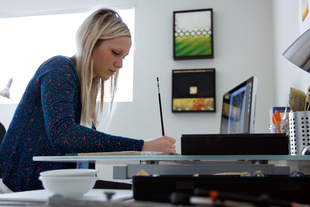
Since that time, have you ever rethought your childhood and seen how your youthful interests then have led you to where you are now?
I think I loved drawing and coloring just as much as any other small child, and I also loved all the colors and pictures I saw in children’s books. In second grade I remember getting really into writing short stories and illustrating them like children’s books. That was really fun for me and at the time my parents thought it was because I loved to write, but I’m realizing now that it was probably because I was looking for a way to visually communicate something and it was the only way I knew how.
I was also raised in a very mathematically minded household, and my dad would always quote Plato: “Geometry will draw the soul towards truth.” He would substitute the word “geometry” with “mathematics,” but it was still the same idea and I always loved when he would say it because I knew he believed it. Truth was something I felt was attainable and I think having that kind of upbringing and exposure prepared me to feel that connection with how geometry can be used in art to find truth.
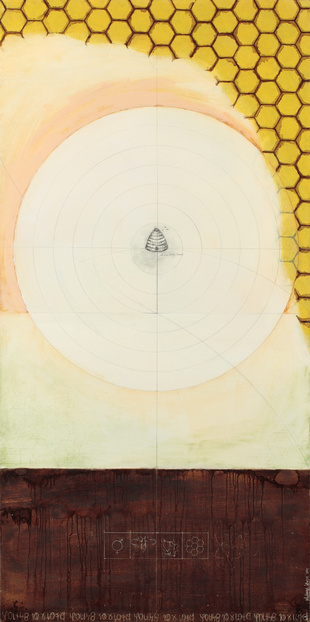
How have you been able to balance being a wife and an artist?
The challenge for me has been in finding a way to do art while at the same time balancing the responsibilities of everyday life like having a job, exercising, keeping an apartment clean, fulfilling church and spiritual responsibilities, and spending time with my husband. It’s been difficult and I am constantly switching around my routines in order to fit in all the things I’d like to accomplish. The most important thing for me to remember is to be flexible but also stay very committed. Hopefully I can prepare now so that I can be ready to maintain my studio practice when the children come.
What is your artistic process? For example, could you explain the process you went through to create “Pattern in All Things,” the theme piece you used for your BFA exhibit?
My process usually starts with my reading, seeing, or hearing something that catches my attention—something that enlightens my mind or something I feel an immediate connection with. Sometimes it is a single word or phrase, a color, or a concept that I feel is personal and significant. From that point I do some research to better understand what it is that I want to communicate, and I usually start on the painting right away. I should probably be better at sketching out my ideas, but my experience has been that once I start, the painting has a mind of its own and things always turn out differently than I expected, which at times is frustrating but can also be very exciting.
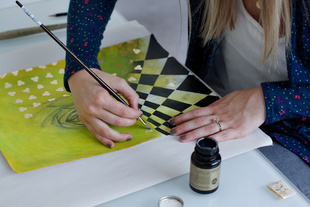
My painting “Pattern In All Things” was actually one of the last pieces I finished for my BFA exhibit. I had seen a similar image elsewhere that had the grid composition, and I was fascinated that each individual square could be a painting of its own, but that together they were unified in one purpose. I used a variety of patterns and symbols (as seen in the other paintings from that body of work) and was able to experiment with color and scale.
What did it feel like to sell your first painting?
It was a surprise and I definitely was not expecting to sell as many as I did. It was a huge blessing and I am still so grateful for the exposure I had at that time. My parents were in town when I sold my first paintings, and my dad actually came with me to meet those who were interested in buying my work. My favorite part about the whole experience was the conversations I had with the people about what the painting meant for them and their connection with the piece.
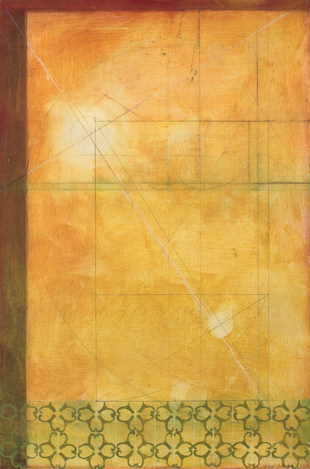
Could you explain some more of the symbolism you have in one of your more recent paintings such as “Words of Isaiah” or “Eternities on my Mind”?
In “Words of Isaiah” I used one-point perspective to suggest the feeling or idea of forward and upward movement, the circle and square which are symbols for heaven and earth, respectively, and the colors are also used as symbols to illustrate the text I included from Isaiah 53:5.
“Eternities on My Mind” is centered around the circle as a symbol for eternity and continual progression, and color symbolism in this painting is also important.

What influence did Wulf Barsch have on you during your time at BYU?
Wulf was my program advisor in the Visual Arts program at BYU and he definitely has influenced the way I think about art and how I make art. What I appreciated most was that he never told me what to paint. That seemed to be a question I had for a few semesters while I went through the art program at BYU. Some professors would give suggestions or try to lead me in the right direction, but Wulf always just asked the question, “What are you after?” The question itself wasn’t really that clear to me at that time and maybe it still isn’t now, but at least it got me thinking about what my purpose was as an artist and I started asking myself why I am making art and what difference I could make with my artwork. I also think his artwork is beautiful and very thought-provoking. He was really inspiring and taught us to always ask questions and continue learning.
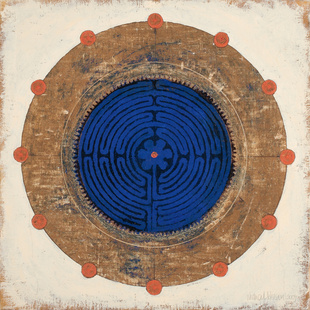
Were there any other influential professors or colleagues during your time at BYU?
I love Wayne Kimball’s lithograph prints, and Sunny Belliston was another professor of mine whose work I love and admire. Her artwork is beautiful and I love the different textures and compositions in her pieces, as well as the variety in materials she uses. Laura Hawkins and Lisa Crosby were two students who graduated before me, but I admired both of them for their work, specifically their choice of color and the compositions in their paintings.
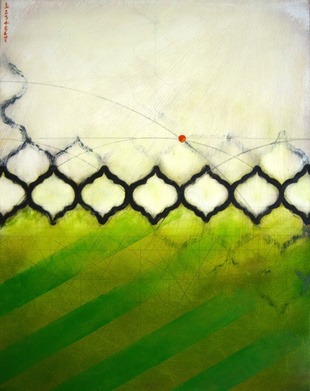
How has your faith and knowledge of the gospel influenced your work?
A week or two before I graduated from BYU, I asked Wulf for one piece of advice on how I could be a successful artist. His answer was, “Understand your religion.” I expected him to say something about how much work it would take and how many hours I would need to spend on my art, but the truthfulness of this simple statement has become clear to me.
Having a knowledge and testimony of the gospel, of where I came from, and of my purpose here has made all the difference in how I view my responsibility as an artist. It also influences the topics and concepts I choose to depict, and I think any artist would benefit from having a spiritual connection to something.
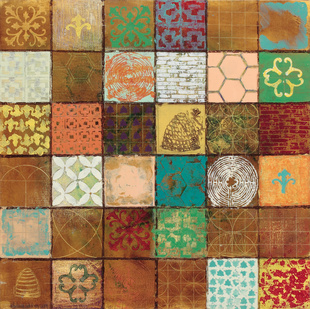
What other artists or paintings have inspired you?
I seem to find a new “favorite artist” every week, but the ones that continue to inspire me no matter how many times I look at their work are Richard Diebenkorn, Marica Myers, Wini Brewer, and Richard Gate. Each time I look at their work I always learn something, and I love seeing how they use color and how they divide the space.
What was it like when you had your first show?
It was a very rewarding experience to have a solo show and I can’t wait for my next one! It was obviously very stressful leading up to it—just the pressure of having everything completed on time and at the quality I wanted it to be. Some paintings were still wet when I hung them but I finished on time. I really enjoyed preparing a body of work for a show and I think it helped me learn and grow as an artist to follow a common theme for each painting. I felt that I really developed my personal style as an artist as a result of preparing for that show.
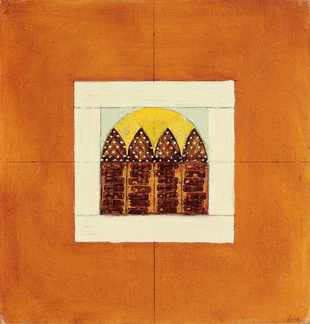
This year you’ve had pieces in two different shows: “Order of Creation” in Revisiting Beauty at the Orange County Center for Contemporary Art in Santa Ana, California, and “Words of Isaiah” in Fine Art & Faith at the White Stone Gallery in Philadelphia. What was the experience like with those shows?
It was a blessing to be accepted into both of those shows and I was so grateful for the opportunity to exhibit my work with other artists. I believe strongly in the purposes of each of those shows and felt that my purpose as an artist was in line with each of the themes for those exhibits. I was unable to see the Philadelphia exhibit, but I did get to attend the opening reception for the exhibit here in California. It was a great experience and I was again grateful to be included in both exhibits.
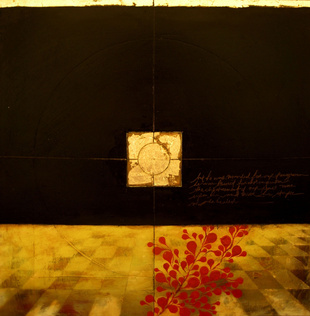
I noticed that you had the opportunity to study in Italy. How did your time there influence your art?
The things I remember most about Italy out of all the things I saw were the cathedrals and stained glass rose windows. The significance and symbolism in the stained glass and cathedral architecture is something I’ve been fascinated with for a long time now. They were beautiful, and even though the cathedrals were sometimes a little gaudy and overly ornate, I felt that whoever designed or built them was worshipping the best way he knew how, and that really left an impression on me.
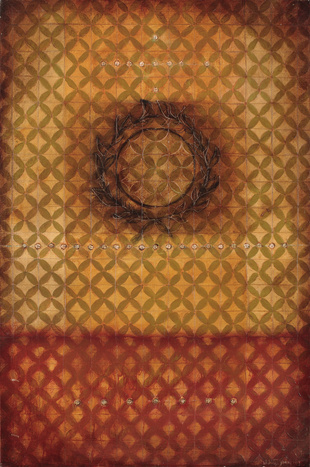
Are there any particular art pieces you saw while you were in Italy that made an impression?
We saw so much art but I definitely had my favorites. One of my all-time favorite pieces of art is Michelangelo’s Pieta, which I saw while I was in Rome at St. Peter’s Basilica. It really is a beautiful sculpture in technique and also in the scene it represents. The ceiling of the Sistine Chapel was exciting to see, and there was a John Singer Sargent exhibit in Venice which I also really loved. Lastly, the Madonna paintings with all the gold leaf were beautiful. In general, I just loved all the figure sculptures.
On your website, your statement says, “Only through abstraction am I able to achieve my true purpose, which is to find truth and beauty on a universal level, and achieve an understanding that is beyond our own reality—an understanding from a different place and time that we once knew and which we will yet arrive.” Could you expound on this?
I’ve thought a lot about why I make abstract art, and I’ve realized that spiritual concepts and spiritual experiences are oftentimes communicated to us through abstract ideas, thoughts, and feelings. Sometimes I use representational symbols in my paintings, but for the most part my work is abstract and conveys a degree of mysticism.
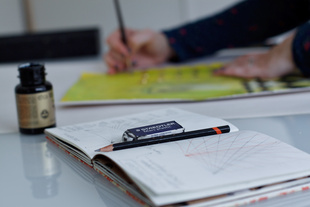
Without being too assumptive, the symbols and concepts I use in my work encourage the viewer to think on a more spiritual level, which has the possibility to give the individual a glimpse of a “nobler sphere” and reach a moment of enlightenment. Every aspect of my paintings is executed with purpose and is placed there for a reason—to add to the overarching spiritual concept of the painting and testify of a truth.
How have you been able to balance being LDS and being an artist?
Being LDS and being an artist are so interconnected in my life that I could never see myself being one without the other. I’ve come to understand my purpose as an artist, which is to share beauty, light, and truth with others, which is only possible for me to do because I am LDS.
How do you see your art helping build the kingdom?
Right now I think my main audience is LDS, but my hope is that I will get more exposure and that I will be able to reach a non-LDS audience as well. All those who are willing can understand and benefit from the concepts I use in my paintings, and hopefully others will want to learn more about what it is that motivates me to create these images. ❧
